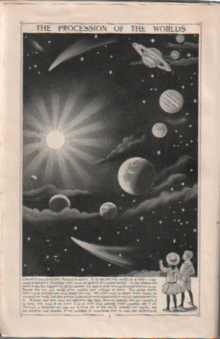- The Children's Encyclopædia
-
The Children's Encyclopædia was an encyclopædia originated by Arthur Mee, and published by the Educational Book Company, a subsidiary of Amalgamated Press of London. It was published from 1908 to 1964. Walter M. Jackson's company Grolier acquired the rights to publish it in the U.S. under the name The Book of Knowledge (1910).
Format and descriptions
The encyclopædia was originally in fortnightly parts between March 1908 and February 1910. Some readers could have bound their collections, but the first eight-volume sets were published in 1910. Each section contained a variety of articles, developing topics as it progressed. The work could be used as a conventional reference library, as the last volume had an alphabetical index, or each section could be read from start to finish. It was originally organised into sections but there were changes in subsequent editions. Some titles covered scientific subjects such as geology, biology and astronomy but such scientific terms were generally avoided.
- Familiar Things, by "Many writers"
- Wonder, by "The Wise Man"
- Nature, by Ernest Bryant and Edward Step
- The Child’s Own Life, by Dr. Caleb Saleeby
- The Earth, by Dr. Caleb Saleeby
- All Countries, by Frances Epps
- Great Lives, by "Many writers"
- Golden Deeds, by "Many writers"
- Bible Stories, by Harold Begbie
- Famous Books, by John Hammerton
- Stories, by Edward Wright
- Poetry, by John Hammerton
- School Lessons, by several writers, including Lois Mee, Arthur's sister
- Things To Make and Things To Do, by "Many writers"
Mee wrote a "Greeting" and a "Farewell". He took a strong interest in the "Book of Wonder", in which the "Wise Man" answered questions by children.
The illustrations were mostly anonymous but some illustrators included Susan Beatrice Pearse, C. E. Brock, Thomas Maybank, George F. Morrell, Dudley Heath, Charles Folkard, H. R. Millar, Alexander Francis Lydon, Arthur A. Dixon and Arthur Rackham. The books used photographs by Frank Hinkins, engravings, maps and graphics.[1]
The Encyclopædia broke ground in the approach to education, aiming to make learning interesting and enjoyable. Its articles were clearly written. It aimed to develop character and sense of duty.
Articles reflected its authors: they were proud of Britain and the British Empire; religion – Christianity was held to be the only true religion; racism – the white race was superior, and there were hints of the eugenic ideas of Caleb Saleeby. Offsetting this was a moderate and liberal standpoint in many areas: other races might be inferior, but they should be treated with respect, and imperialism was justified only if it improved the lot of its subjects. At a time when the relation between science and religion was controversial, the Encyclopædia supported evolution, but it did not admit any contradiction between the two.[2]
It was sold door-to-door. It was used by schools and for teacher training. It gives insight into the social values of the society that created it and was influenced by it.As the initial run ended, it was reissued as the monthly New Children's Encyclopædia. The title changed, becoming Children's Encyclopædia Magazine, Children's Magazine and, finally, My Magazine in 1914. From September 1910, the magazine included a supplement of news entitled The Little Paper, the forerunner of Arthur Mee's Children's Newspaper, launched in 1919.
The Children's Encyclopædia sold 800,000 copies in 12 editions before being extensively revised in the early 1920s. The new 59-part, 7,412-page, 10-volume series debuted in October 1922 as The Children's Encyclopedia, the digraph having been dropped, and went through 14 editions by 1946 under the imprint of The Educational Book Co.. Translations appeared in France, Italy, Spain and China.
New editions of the Encyclopedia continued after Mee's death in 1943; the final, much revised, edition, still entitled Arthur Mee's Children's Encyclopedia, appeared in 1964.
References
- ^ The Children's Encyclopædia, edited by Arthur Mee (1910), 8 volumes; and later editions.
- ^ Cf. Tracy (2008)
- John Hammerton (1946) Child of Wonder: An Intimate Biography of Arthur Mee.
- Maisie Robson (2003) Arthur Mee's Dream of England.
- Michael Tracy (2008) The World of the Edwardian Child, as seen in Arthur Mee's Children's Encyclopædia, 1908–1910.[1] Includes more information and a new assessment of Mee and his work, also that of other contributors to the Encyclopædia.
External links
Categories:- 1908 books
- British children's books
- British encyclopedias
- Children's encyclopedias
- English-language encyclopedias
Wikimedia Foundation. 2010.

